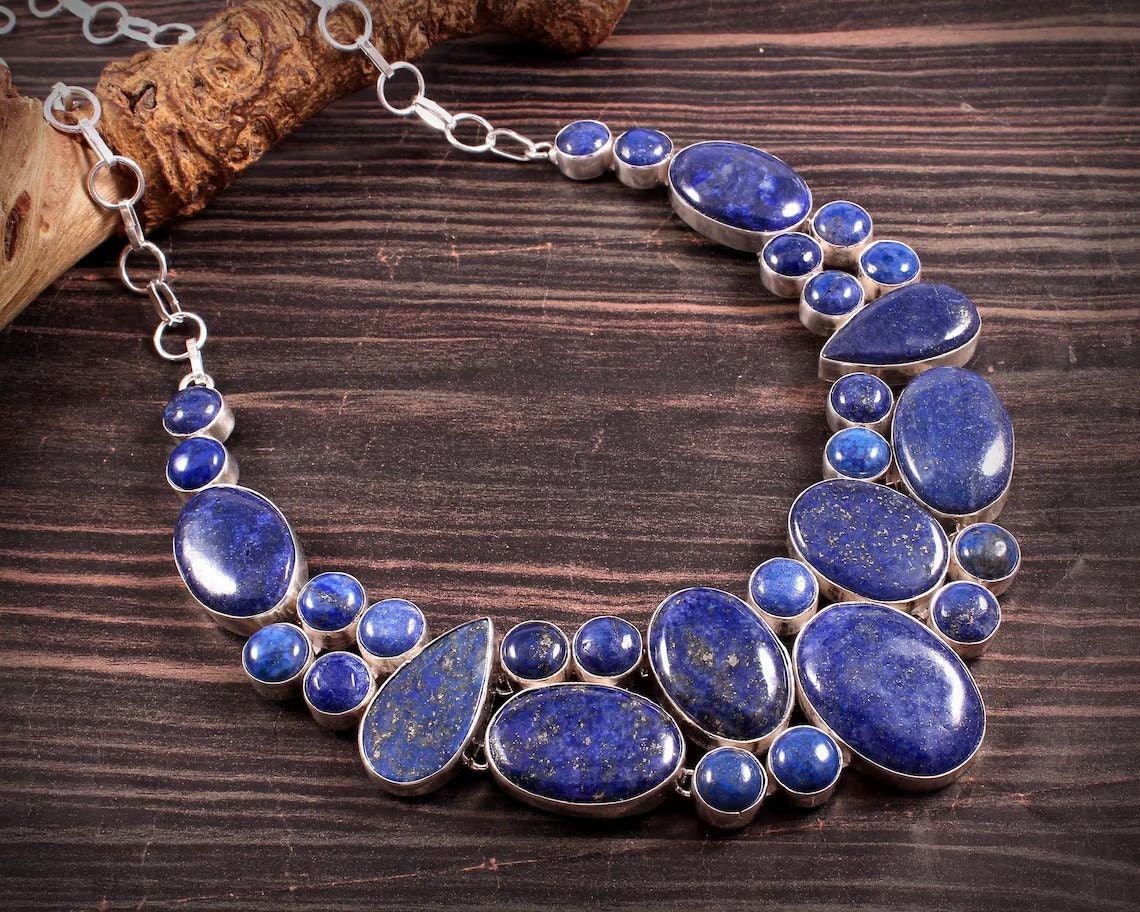We do not currently have any lapis jewelry for sale -- the necklace above is from a fellow Etsy seller you can check out here.
Lapis Lazuli is a vibrant blue gemstone treasured for its deep, rich color. It is not a pure mineral, but rather a rock composed of varying proportions of minerals; lazurite, sodalite, hauyne, calcite, and pyrite. It is primarily the result of contact metamorphism of certain limestones and is found in large deposits at a few locations in the world. The main historical mining site has always been in Northern Afghanistan. Secondary deposits may be found in Siberia, Canada, and Chile, where the material is generally lower grade.
History
Lapis Lazuli has been used in jewelry since ancient times, as early as 6,000 B.C. Beads, jewelry and lapis carvings have been found in numerous archeological sites from that time onward, indicating a spread in use from Afghanistan throughout the Middle East and Egypt, to Asia and the Roman World. The name "lapis lazuli" derives from the Persian word, "lazhward", and means blue stone.
Throughout the Latin-speaking Roman World, the word "sapphirus" was used with the same meaning, which has led to speculation that in certain historical sources, the sapphires of antiquity were lapis lazuli. The Egyptians long valued this stone, not only as a source of carving and inlay material but also in ground form as a cosmetic, such as blue eyeshadow. Painters from pre-Renaissance times until the Modern Era used ground lapis as the pigment, ultramarine. This old formula is still used today by museum conservators and also forgers.
Today, lapis lazuli is predominately used in jewelry applications, most often set in silver and modestly priced. However, to emulate jewelry from earlier eras, lapis is also being upscaled and seen alongside diamonds and other colored gemstones in luxe gold settings.
Lapis has always been a gem of choice for inlays, insets, and intarsias. How could any gem artist resist the contrast and eye appeal of its vibrant blue color? Lapis carvings are still a popular item, and it is also available in baroque and round beads.
Colors
The colors of lapis lazuli vary; medium-grey blue, intense royal blue, and deep indigo, with varying amounts of white and brassy gold, depending on the level of calcite and pyrite in the stone. Some purists desire a gem that is almost entirely lazurite, in a deep uniform blue, but most seek a piece with a moderate to generous sprinkling of golden pyrite. "Pliny the Elder", in his famous ancient treatise on all things natural, called lapis lazuli "a fragment of the starry firmament", in admiration of the deep blue color with twinkling bits of gold. Although they don't agree as to how much pyrite is ideal, most admirers and collectors of fine lapis agree that the less calcite, the better. White calcite can be seen as streaks or patches within the darker blue or can predominate in the mix giving the rock an overall lighter blue shade.
Denim Lapis and Synthetics
The enduring popularity of denim country and Western clothing have given marketers a niche for what once was considered low-quality, virtually unsalable lapis lazuli from Chile. Aptly dubbed, "denim lapis," it is sold widely on home shopping channels, the Internet, at swapmeets, flea markets, and through direct mail catalogs. Lapis lazuli has been successfully synthesized by Gilson in France and Chatham in the USA. Many of the large jewelry supply houses offer the synthetic version with and without pyrite inclusions. Although synthetics are a modern invention, lapis simulants go back at least as far as early Egyptian times.
Artifacts using glass, backed with blue paint, and blue ceramic materials instead of lapis, include the famed King Tut Death Mask. Such items attest to the Ancient's love of this dark blue gem, and the ingenuity they used to simulate it when the natural material was scarce or too costly.
Modern-era simulants include enamel, glass, plastic, and a variety of dyed gems such as howlite and jasper, also known as "Swiss Lapis." Sodalite is the only natural gemstone readily available in large enough sizes and in a deep enough blue to be a convincing lapis simulant.
Spiritual Significance and Birthstone
Perhaps it is this gemstone's long history, or striking color that makes it such a highly significant stone amongst those who ascribe mystical, spiritual, or healing properties to gemstones. It is an alternate birthstone for September in the European/American system and has prominent positions in other systems as well.
Care of Lapis Lazuli
Although lapis lazuli has a hardness of only 5-6 it is widely used in rings and bracelets. However, due to its relative softness, when collecting lapis jewelry look for protective settings, or limit your wear of the piece. Expect to repolish the piece occasionally. Pendants, earrings, brooches, tie, and lapel pins can be worn daily with little worry. Avoid steam, chemical solvents, and ultrasonic cleaning systems. The old standby of a soft brush and mild soap would be safest.
Value
The value of lapis lazuli is determined almost exclusively by color. Specimens exhibiting a deep, intense blue with violet tones are most prized. Fine-grained, uniform specimens attain a smooth, highly-polished surface not seen in lower grades. Calcite inclusions always lower the value, pyrite inclusions enhance it. For lapis jewelry, the value is determined by all these things, and the artistry of the design is paramount.
Gemological Data
Makeup: rock containing a variable mixture of lazurite and other minerals Luster: vitreous to greasy Hardness: 5-6, depending on composition Crystal structure: Various Cleavage: none Density: 2.8 RI: 1.50 (mean) Birefringence: none Dispersion: none
